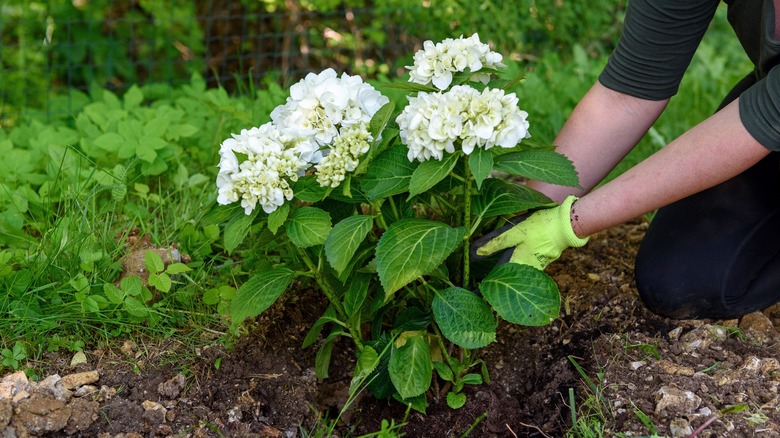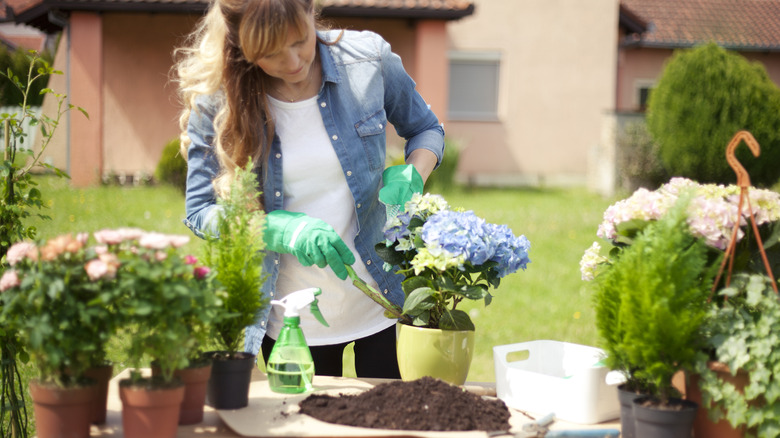The Stress-Free Way You Can Transplant Hydrangeas This Spring
Whether you're planting hydrangeas from a store-bought root ball or from another area of your yard, the risk of transplant shock can be nerve-wracking. The last thing you want is to put time and effort into your garden, only to see your beautiful plants struggling to bloom and thrive. Fortunately, there's a simple way to avoid transplant shock for your hydrangeas: by giving them a seaweed bath, you can boost the health of your hydrangeas and decrease the stress of transplanting — for yourself and for your plants!
Hydrangeas come in a variety of different species, and each type requires its own specific climate and unique growing conditions. While the seaweed bath will help pave the way for a successful transplant, it won't outweigh the importance of choosing the best hydrangea varieties to have in your garden and the ideal location for your plants. If you're selecting a new hydrangea to transplant in your garden, carefully consider your conditions and your local zone to select the best fit for your needs.
For example, smooth hydrangea (Hydrangea arborescens) can thrive in USDA agricultural zones three through nine and prefer partial sun to shade and well-drained soil. On the other hand, climbing hydrangea (Hydrangea anomala) is only hardy in zones four through seven, prefers mostly sun, and can adapt to any soil conditions. But there comes a time in every hydrangea's life when their roots outgrow their confinement and you need to transplant them, which is where the seaweed bath comes in.
How and why does a seaweed bath work?
Seaweed helps give plants a natural boost because it contains important nutrients, including magnesium, phosphate, nitrogen, and potassium. Plus, some seaweed products contain trace elements that improve soil health, as well as cytokinins that stimulate growth in plants. This mixture of nutrients helps set up your hydrangeas for success during the transplant process, which can otherwise be stressful for your plants.
To use this method for transplanting, start with a potted hydrangea plant. Whether you've dug up a plant of your own with plans to move it or you've purchased one at a garden center shouldn't make much of a difference. Purchase liquid seaweed online or at your local hardware store. You can find it at Ace Hardware for less than $15 for a quart-sized bottle.
In a bucket larger than the pot your plant is in, mix up a solution of liquid seaweed according to the instructions on the bottle. Carefully lower the entire hydrangea pot into the seaweed solution and let it soak for at least a few minutes until you don't see any air bubbles arising on the solution's surface. You can leave it soaking while you prepare the hydrangeas' next pot or hole, then remove the plant and transfer it to its new home.
More tips for transplanting hydrangeas
If you're digging up a hydrangea plant from another location in your yard, ensure that you choose a time when the plant is dormant. Late fall is the best time to transplant hydrangeas since they can use the winter to remain dormant and adapt to their new location. If you'd prefer to move yours in the spring, first find out what a dormant hydrangea really looks like before you begin to dig, then dig up as much of the root ball as possible during a cooler time of the day to prevent unnecessary disturbance.
Once you're ready with your seaweed-soaked hydrangea plant, dig a new hole as deep as the root ball and twice as wide on all sides. Amend the soil you've dug out of the hole using compost, and if you live in a dry area, add coco husk for moisture retention. Then, place the root ball carefully in the hole, and add the amended soil back to fill it in.
Don't be alarmed if your hydrangea doesn't thrive and produce lots of blooms in the first year after transplanting, especially if you transplanted in the spring. The best way to help them establish themselves in their new spot is to deeply water them about every three days, especially during the summer heat.


